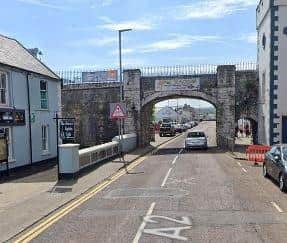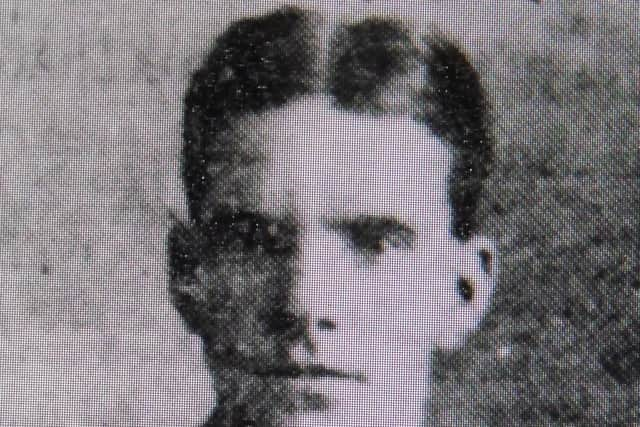NI Centenary: Secretary of War’s Carnlough connection
and live on Freeview channel 276
Lord Vane Tempest and the 16 others died when, owing to an error, two trains had both been given the go ahead to proceed from opposite directions and collided head-on at Abermule station; the event remains the worst single track accident in British Railway history.
The untimely death of Vane Tempest resulted in the Secretary of War, Winston Churchill, becoming landlord of the family estates in Antrim, including Carnlough village. Lord Herbert Vane Tempest was grandson of Anne, Countess of Londonderry, as was Churchill’s father, Lord Randolph Churchill, and as a result Winston inherited the estate. The family home at Garron Tower, however, did not pass to Churchill; it had been rented since 1900 as a hotel and purchased some time earlier from the family.
Advertisement
Hide AdAdvertisement
Hide AdChurchill had other matters to draw his attention across the Irish Sea. As Secretary of War he was deeply aware of the increasing violence and lawlessness which was developing as the Anglo-Irish War continued. Republicans were fighting for separation from the United Kingdom, the authorities in Dublin Castle becoming almost overwhelmed as a campaign against the Royal Irish Constabulary resulted in murders and defections.


The Larne Times carried detailed reports on a number of incidents that month, including a bomb attack on the RIC barracks at Rasharkin. A gun battle had occurred for 45 minutes between police and a group of around 20 armed men who placed two bombs outside the building at 4.30am.
Several of the officers were injured and blood was also found in a location were the assailants had fled.
A further incident occurred between Parkmore and Waterfoot, where trees were cut down to block a road. The intended targets of an ambush – police from Cushendall – had passed along the road earlier, however, and the only people inconvenienced were those who had to detour via Carnlough to get to Cushendall.
Advertisement
Hide AdAdvertisement
Hide AdMore serious incidents had occurred elsewhere, including the shooting dead of two Protestant farmers at Skibbereen in County Cork. Matthew Sweetnam (65) and William Connell (60) were shot by the same gang. In Connell’s case his wife was held captive while her husband was shot in the head. Both men had given evidence in a trial against Florence McCarthy, a rural councillor subsequently imprisoned for collecting for the IRA arms fund in the area.


Another shooting followed a trial by a republican court martial, when John Bradfield, a Protestant farmer from Bandon, near Cork, was found guilty of intending to give information to the army about republican forces. The Larne Times reported that about two days before his death he was visited by six men in military uniform whom he took to be British officers. He had given them tea and in the course of conversation mentioned a forthcoming ambush which he had heard about. It turned out, however, that the men were in disguise.
“Loyalists in the martial law area are placed in a position of terrible danger between their liability to punishment under martial law if they do not give all the information in their possession as to Sinn Feiners on the one hand and their liability to be shot by the latter if they are discovered doing so,” the paper detailed.
Meanwhile, a Belfast RIC man visiting his wife’s family in Maryborough, Queen’s County, had been shot dead after only serving two weeks in the police. Constable William Vanston (26) came from a police family. He had served in the Royal Engineers during the war and had been working with two brothers in Scotland prior to joining up. He was one of several policemen shot dead during the course of the month.
Advertisement
Hide AdAdvertisement
Hide AdThe future prime minister of Northern Ireland was to be Sir James Craig, the Ulster Unionist Council ratifying him as leader of the Unionist Party that month. The Larne Times said that “No man who is thinking of his personal ease covets the position,” reflecting on the turbulent times and the onerous responsibility Craig would face. Sir Edward Carson, who had declined the position owing to his age, spoke warmly of the man who had been his trusty lieutenant. And in a speech at Torquay he also said that the Ulster Unionists had accepted a Home Rule parliament in Belfast for “the benefit of the United Kingdom and the Empire”.
Local political news included formation of a Unionist branch at Cairncastle, chaired by William Chaine DL, and a meeting of the Larne Trades Council, where consideration was given to fielding candidates in the forthcoming Ulster parliamentary election.
But it was not all politics. At Islandmagee there had been a meeting chaired by Rev. David Steen, which decided to approach the Larne District Rural Council to ask for a landing place and small port to be constructed at the Wrack Knowe to facilitate ferry travel across from Larne.
Also in Islandmagee a plaque in honour of seamen attached to the congregation lost during the war had been unveiled at the Methodist Church by James Earls. James Coey of Ardeen had died after a short illness. A nephew of Sir Edward Coey and Sir Hugh Smiley, he was described as well-known and liked in his native town. He was also renowned as a horticulturalist (owning a nursery garden at Newcastle, Co. Down) and President of the Irish Shorthorn Breeders Association.
Advertisement
Hide AdAdvertisement
Hide AdAnother local man, Malcolm Shannon, was being sought by his sister. He had last been heard of in San Francisco about 20 years before and an appeal for information appeared in the Relatives Missing column in the Larne Times, where his sister Agnes (now McQuitty) lived at Mill Lane. The column was a regular feature and highlighted how contacts were sadly lost as family members moved to other parts of the world.
Click here to read: Council unveils bespoke logo for NI Centennial celebrations
--
Thank you for reading this article. We’re more reliant on your support than ever as the shift in consumer habits brought about by coronavirus impacts our advertisers. Please consider purchasing a copy of the paper. You can also support trusted, fact-checked journalism by taking out a digital subscription of the News Letter.